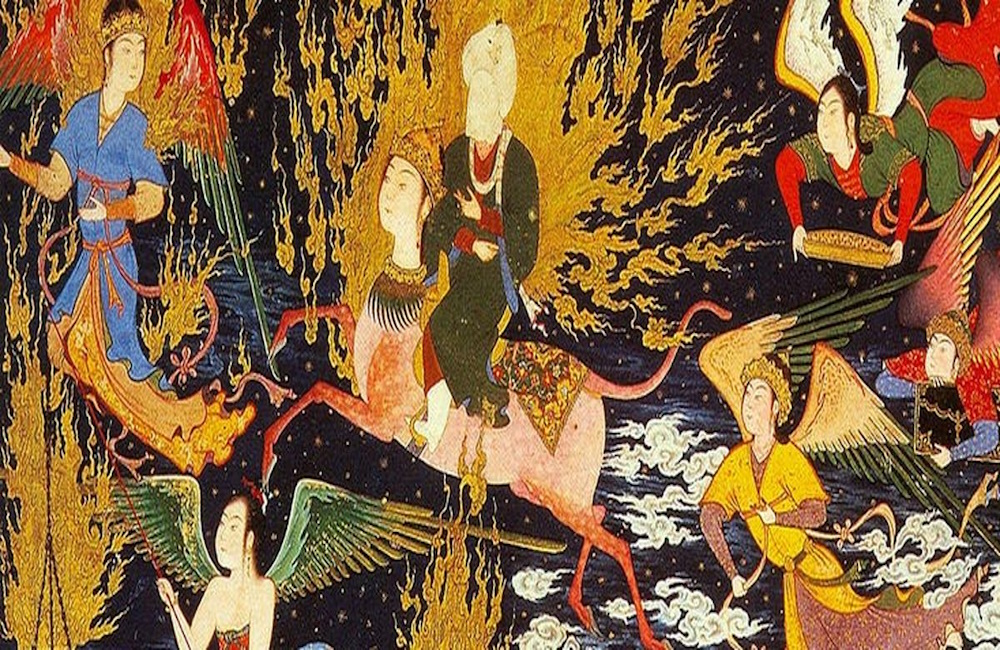The Isra: The Night Journey from Mecca to Jerusalem
The Isra marks the first phase of Muhammad’s journey, where he is believed to have been transported from the Sacred Mosque in Mecca (Al-Masjid al-Haram) to the Al-Aqsa Mosque in Jerusalem. This journey, according to Islamic tradition, was made possible by Buraq, a creature described as larger than a donkey but smaller than a mule, capable of covering vast distances in an instant. Upon arriving in Jerusalem, Muhammad is said to have tethered Buraq and led a prayer with previous prophets at the Al-Aqsa Mosque.
The Mi’raj: The Ascension Through the Seven Heavens and the Negotiation of Daily Prayers
Following the journey to Jerusalem, the Mi’raj describes Muhammad’s ascent through the seven heavens. As Muhammad ascended, he encountered various prophets at each level. In the first heaven, he met Adam, who welcomed him. In the second heaven, Muhammad encountered Jesus (Isa) and John the Baptist (Yahya), both of whom expressed their support for him. In the third heaven, he met Joseph (Yusuf), who greeted him with respect. As Muhammad continued his ascent, he encountered Enoch (Idris) in the fourth heaven, Aaron (Harun) in the fifth heaven, and Moses (Musa) in the sixth heaven. Moses, in particular, played a significant role in advising Muhammad on the burden of daily prayers for his followers. Finally, in the seventh heaven, Muhammad met Abraham (Ibrahim), who greeted him as part of the prophetic tradition. At the highest point, Muhammad is believed to have been in the presence of God (Allah), where he was instructed that Muslims should pray fifty times a day. After consulting with Moses, Muhammad returned to God multiple times to request a reduction, eventually negotiating the number down to five daily prayers.
The Dialog between Moses and Muhammad: Sahih Bukhari, Book 54, Hadith 429; Sahih Muslim, Hadith 164; Sunan Abu Dawood, Hadith 149
The discussion between Muhammad and Moses regarding the number of daily prayers is a notable aspect of the Mi’raj narrative. Here is a reproduction of the dialogue based on Islamic tradition:
After Muhammad’s ascent through the seven heavens, he reached the highest level, where he was in the presence of God (Allah). At this point, God instructed Muhammad that Muslims were to pray fifty times a day. Upon receiving this command, Muhammad descended through the heavens and encountered Moses (Musa) in the sixth heaven. Moses, recognizing the potential difficulty such a demanding requirement could impose on the Muslim community, inquired about the specifics of the command.
Moses (Musa): “What did Allah instruct you?”
Muhammad: “He commanded that we pray fifty times a day.”
Moses (Musa): “Your followers will not be able to bear this burden. I have experience with people and their commitments; it will be too much for them. Go back to Allah and request a reduction.”
Muhammad, following Moses’s advice, ascended again to the presence of God and requested a reduction in the number of daily prayers. Allah agreed to reduce the number from fifty to forty. Upon returning to Moses, Muhammad was advised once more to seek a further reduction, as forty prayers would still be burdensome for his followers. Muhammad ascended again and asked Allah for another reduction. This process was repeated multiple times, with each reduction being met with the same advice from Moses, until the number of daily prayers was eventually reduced to five.
Moses (Musa): “Five prayers a day are still significant, but they are manageable. Your followers will be able to fulfill this obligation.”
Muhammad then returned to his followers with the final command of five daily prayers, which remains a fundamental practice in Islam.
Conclusion on Muhammad’s Journey: Isra and Mi’raj
The accounts of Muhammad’s Night Journey (Isra) and Ascension (Mi’raj) raise several historical and critical questions. Firstly, the historical context of the Isra journey presents contradictions. At the time of Muhammad’s journey, Jerusalem did not have an Al-Aqsa Mosque, as it was constructed centuries later. The Jewish Temple, where Muhammad is said to have met past prophets, had been destroyed by the Romans in 70 AD. Additionally, the notion of prophets from different eras meeting is unusual in biblical tradition, with the sole exception being Jesus, who is considered divine rather than merely a prophet.
Secondly, the Mi’raj and the negotiation over the number of daily prayers bear a striking resemblance to the biblical account of God’s dialogue with Abraham regarding Sodom and Gomorrah. In both narratives, a figure intercedes and negotiates with God, leading to a change in divine command. This parallel strongly suggests that the story of Muhammad’s negotiations may be derived from or inspired by earlier traditions, rather than being an original revelation.
This narrative is found in Genesis 18:16-33 in the Bible
God reveals to Abraham His intention to destroy the cities of Sodom and Gomorrah due to their grave sins. Abraham, concerned for the righteous people who might be living in those cities, engages in a dialogue with God. He begins by asking if God would spare the cities if fifty righteous people were found there. God agrees. Abraham then continues to negotiate, progressively lowering the number from fifty, to ten, each time God agrees to spare the cities if that number of righteous individuals is found. The negotiation demonstrates Abraham’s concern for justice and mercy and God’s willingness to consider intercession in His judgments.
Lastly, the description of Buraq, the winged steed, may have been influenced by pre-existing cultural artifacts. According to Sunan Abu Dawood (Hadith 4932), Muhammad allegedly saw a winged horse among Aisha’s toys, which was interpreted as Solomon’s steed. This could have influenced the depiction of Buraq. Additionally, similar winged creatures, such as the Lamassu from Assyrian civilization and Kamadhenu from Hinduism —winged bulls with human heads—may have served as inspiration for the Buraq imagery.
Overall, these historical inconsistencies and similarities with earlier traditions cast significant doubt on the authenticity of these stories, suggesting that they may be adaptations of existing myths and legends rather than genuine revelations.
